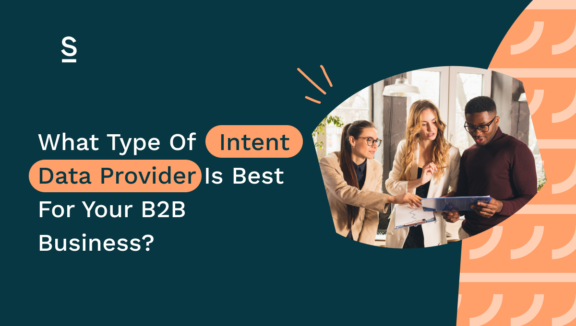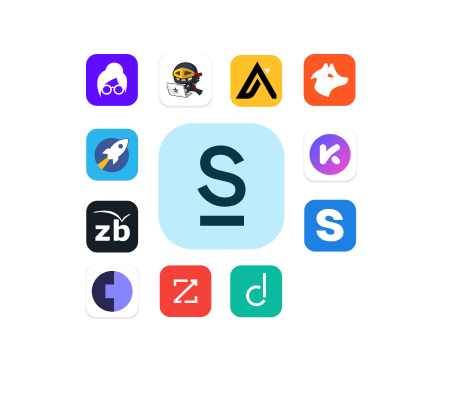What Type Of Intent Data Provider Is Best For Your B2B Business?

99% of large companies are already leveraging intent data in some way.
And since that that same percentage report increases in sales or ROI, growing businesses arrive at a stage where they look to start using intent data in their sales strategies.
If you’re looking to leverage user intent data, you’ll need more than just the data your website captures. Luckily, there are multiple third party data platforms you could use.
This article looks at all areas of buyer intent data, including what it is, how it works, and how salespeople can use the data once you have it.
Key Takeaways:
- What are the different types of buyer intent data?
- What type of intent data provider is best for your B2B business?
- How to make intent data useful to the salespeople using it
What is buyer intent?
Buyer intent refers to the collection of signals that indicate a potential customer’s interest in a product or service. These signals can come from various interactions the customer has with a business online, such as visiting a website, engaging with content, or searching for related topics.
Understanding buyer intent is crucial for sales prospecting as it helps identify prospects who are more likely to convert into customers. You can learn everything you need to know about B2B buyer intent here.
By analyzing these signals, companies can tailor their marketing and sales strategies to meet the specific needs of potential buyers, making the sales process more efficient and increasing the likelihood of a conversion.
73% of B2B marketers report that they are already using, or planning to use intent data in the year ahead
What are the different types of buyer intent data?
Buyer intent data can be categorized into three main types based on its source and how it’s collected:
First-Party Buyer Intent Data
This type involves data gathered directly from interactions with your own business’s channels, such as website visits, product demo requests, or newsletter sign-ups. It provides the most direct insights into your prospects’ interests and behaviors.
Second-Party Buyer Intent Data
Obtained through partnerships or collaborations, this data comes from a trusted business ally and can provide deeper insights due to the shared interests of both parties’ audiences.
Third-Party Buyer Intent Data
Sourced from external data providers, this type captures a broad spectrum of intent signals across various platforms and industries. It extends the reach beyond your immediate audience and can uncover trends and potential leads that are not directly connected to your business’s existing networks.
Two-thirds of B2B’s report using a combination of both first-party and third-party data
What Type Of Intent Data Provider Is Best For Your B2B Business?
Traditional Data Providers
These providers focus primarily on third-party data, with their services priced based on the amount of data your business consumes. They are ideal for companies needing extensive external market insights.
ABM Platform Providers
These platforms integrate third-party intent data into their services, enhancing both analytics and campaign tools. This data is typically included within the platform’s subscription fee, providing a comprehensive solution for account-based marketing strategies.
Campaign Execution Firms
These firms offer a blend of second- and third-party data, which supports tailored marketing and sales campaigns. The costs are usually embedded in the activation fees or are calculated on a cost-per-lead basis, making it a versatile choice for dynamic sales needs.
Walled Gardens
Specializing in second-party data, these providers collect detailed user information from their proprietary platforms, such as review sites or forums. Their pricing models are similar to those of traditional data providers, catering to niche markets with specific data needs.
Over 25% of businesses are using purchase intent data to deliver ads and campaigns to companies with a high engagement potential
Most Companies Will End Up Buying From More Than One Data Provider
It’s common for companies to purchase buyer intent data from multiple providers to enable their sales teams with comprehensive and accurate data and insights. Having access to a wider array of data points and perspectives can be a big plus to understanding how your audience thinks.
However, having to depend on multiple sources for your intent data can be costly, and generates more admin to manage the data. The expenses involved and the time required to analyze and integrate different data streams into actionable intelligence often require significant resources.

15 data providers in one tool for free
Source verified professional email addresses and mobile numbers with unmatched find rates and global coverage, natively within LinkedIn.
How to Make Intent Data Useful to the Salespeople Using it
Intent data is crucial for sales teams as it sheds light on prospective buyers’ interests and behaviors, offering a strategic edge in the sales process. But in order for this to increase conversion rates, salespeople have to be able to access, use, and understand this data.
Transforming Data into Actionable Insights
Before intent data can drive sales, it must be converted into clear, actionable insights that salespeople can apply directly during prospecting. Three valuable types of insights include:
- Interest Level Insight: Gauge prospect engagement by tracking their interactions, such as website visits or content downloads, to prioritize high-interest leads.
- Product-Specific Interest: Identify which products or services a prospect is investigating to tailor communications and offers around those products.
- Buying Stage Identification: Understand where a prospect stands in the buying cycle to optimize the timing and content of outreach.
Integrating Intent Data with Sales Tools
Integrating intent data seamlessly into the tools that sales teams use daily is essential for maximizing its utility and helping your team have the biggest impact on the bottom line.
Visibility in Key Tools: Embed intent data insights within CRM systems and other sales platforms to ensure they are accessible where sales activities are managed.
Timeliness of Data: Deliver intent data when it’s most relevant, especially offering recent or real-time insights at pivotal moments in the sales cycle, to empower salespeople to act quickly.
By focusing on these practices, sales teams can effectively transform raw data into strategic advantages, which can dramatically boost sales outcomes.
Let’s wrap it up!
Intent data has the power to transform how businesses do sales, but only if that data is managed, understood, and used properly. Once it is, it can help salespeople be more efficient, hit their KPIs, and build stronger working relationships with customers.

Bring your CRM to LinkedIn
Close the gap between your intent data and your sales team by connecting your CRM to LinkedIn with Surfe.
FAQ about Intent Data Providers:
What is an intent data provider?
Intent data providers help sales teams make better decisions by understanding the digital trials of your customers. These providers collect and analyze data signals to identify buying patterns and trends, allowing sales people to better understand where they are in the buyer’s journey.
What is the role of a data provider?
Data providers collect user data from a mix of sources, then package it, and sell it to other companies. The data is gathered and consolidated into categories to facilitate audience segmentation and targeting.
Is using intent data in sales worth it?
Measuring Intent helps you target content, ad campaigns, and account-based marketing (ABM) to the people most interested in your products and services, letting you sell more efficiently while getting an edge over your competitors.
How big is the B2B intent data market?
The Global B2B Buyer Intent Data Tools Market was valued at $ 2.6 billion in 2019 and is expected to reach US$ 6.5 billion by 2027.


